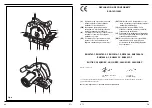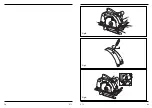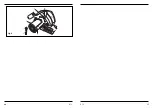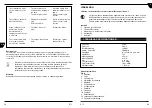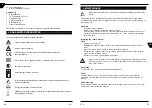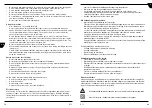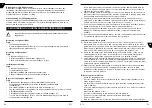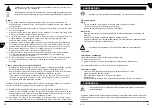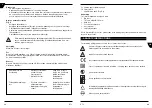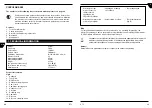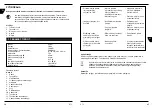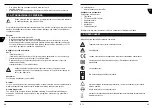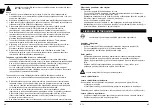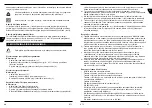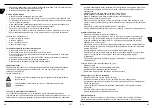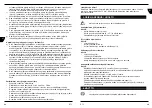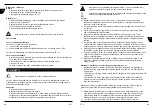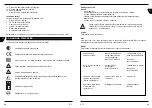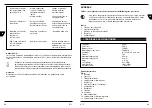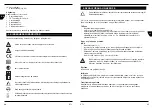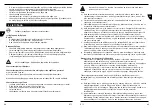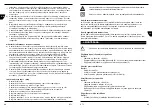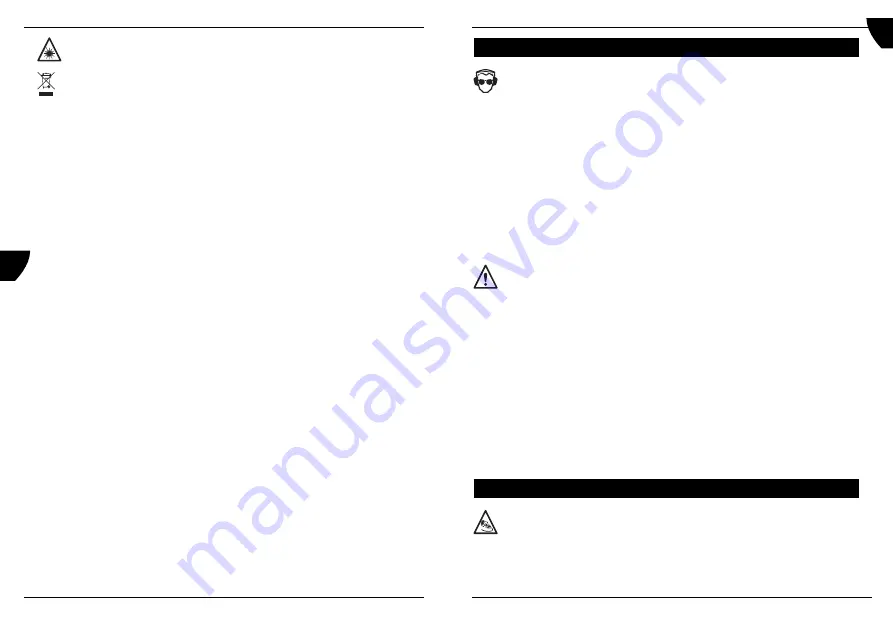
ETC
11
4. ANVÄNDNING
Användning av hörselskydd rekommenderas när man använder cirkelsågen.
Till- / frånkoppling
Fig.E
•
Tryck in knapp (B) med tummen i din högra hand och håll den intryckt.
•
Tryck sen in knapp (A). Cirkelsågen rör nu på sig.
•
Genom att släppa upp knapp (A) stannar cirkelsågen.
Att ta i drift
•
Kläm fast arbetsstycket så att båda händerna är fria för att hålla fast cirkelsågen och
styra den.
•
Koppla till cirkelsågen och placera sågdelen på arbetsstycket.
•
Flytta den långsamt efter i förväg inritad såglinje och skjut cirkelsågen långsamt framåt.
•
Tryck sågdelen kraftigt mot arbetsstycket.
Låt cirkelsågen göra jobbet! Tryck därför inte alltför hårt mot cirkelsågen.
Laserstråle
Laserstrålens användning
Laserstrålens ledande stråle gör det enklare att såga rakt:
a) längs en ritad linje eller
b) genom att rikta in den på en fast punkt som är markerad på arbetsstycket.
Laserstrålens räckvidd är ca. 65 cm beroende på omgivande ljus.
Justera laserstrålen
•
Transporter och tung användning kan påverka laserstrålens precision.
•
Själva laserstrålen kan lätt justeras.
•
Håll cirkelsågens blad mot en linjal eller rak planka.
•
Slå på lasern.
•
Kontrollera om laserstrålen löper parallellt längs kanten på linjalen eller plankan.
5. UNDERHÅLL
Tillse att maskinen inte är spänningsförande när underhållsarbeten utförs på de
mekaniska delarna.
Apparaten är konstruerad för långsiktig användning med minimalt underhåll. Att du är nöjd
med användningen senare är beroende av den riktiga apparatvården och av regelbunden
rengöring.
70
ETC
Caution! Laser beam! Never look into the light beam and never aim the laser
at a person when it is switched on.
Electrical or electronic devices and machines, which are damaged and/or are to be
discarded, must be delivered to the recycling stations provided by local regulations.
Danger
a)
Keep hands away from cutting area and the blade. Keep your second hand on
auxiliary handle, or motor housing. If both hands are holding the saw, they cannot be
cut by the blade.
b)
Do not reach underneath the workpiece. The guard cannot protect you from the blade
below the workpiece.
c)
Adjust the cutting depth to the thickness of the workpiece. Less than a full tooth of the
blade teeth should be visible below the workpiece.
d)
Never hold piece being cut in your hands or across your leg. Secure the workpiece to
a stable platform. It is important to support the work properly to minimize body
exposure, blade binding, or loss of control.
e)
Hold power tool by insulated gripping surfaces when performing an operation where
the cutting tool may contact hidden wiring or its own cord. Contact with a "live" wire
will also make exposed metal parts of the power tool "live" and shock the operator.
f)
When ripping always use a rip fence or straight edge guide. This improves the
accuracy of cut and reduces the chance of blade binding.
g)
Always use blades with correct size and shape (diamond versus round) of arbour
holes. Blades that do not match the mounting hardware of the saw will run
eccentrically, causing loss of control.
h)
Never use damaged or incorrect blade washers or bolt. The blade washers and bolt
were specially designed for your saw, for optimum performance and safety of
operation.
Causes and operator prevention of kickback
•
Kickback is a sudden reaction to a pinched, bound or misaligned saw blade, causing
an uncontrolled saw to lift up and out of the workpiece toward the operator;
•
When the blade is pinched or bound tightly by the kerf closing down, the blade stalls
and the motor reaction drives the unit rapidly back toward the operator;
•
If the blade becomes twisted or misaligned in the cut, the teeth at the back edge of
the blade can dig into the top surface of the wood causing the blade to climb out of
the kerf and jump back toward the operator.
Kickback is the result of saw misuse and/or incorrect operating procedures or conditions
and can be avoided by taking proper precautions as given below.
a)
Maintain a firm grip with both hands on the saw and position your arms to resist
kickback forces. Position your body to either side of the blade, but not in line with the
blade. Kickback could cause the saw to jump backwards, but kickback forces can be
controlled by the operator, if proper precautions are taken.
b)
When blade is binding, or when interrupting a cut for any reason, release the trigger
and hold the saw motionless in the material until the blade comes to a complete stop.
S
FI
DK
N
EE
LV
LT
GB
S
FI
DK
N
EE
LV
LT
GB


